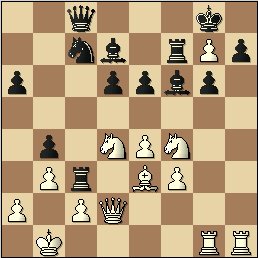
Rook sacrifices on h7
I begin with a nice win by Anand using this theme, and then an analysis of similar Rh7 sacrifices Anand's win in the following seems almost effortless, and it is worth noting straight away that he used less than an hour in the following game. Truly scary to think that he is so clearly capable of even more complex attacks!
1.e4 c5 2.Nf3 d6 3.d4 cxd4 4.Nxd4 Nf6 5.Nc3 Nc6 6.Bg5 e6 7.Qd2 a6 8.0-0-0 Bd7 9.f3 Be7 10.Be3 Rc8 Novelty More prudent is h5 to prevent g2-g4 11.g4 Na5 12.Kb1 A useful precaution in most lines, removing the king from the c-file and off the c1-h6 diagonal. King safety is a common preliminary to pushing the kingside pawns. 12...b5 Often with the idea of b5-b4 and/or Nc4 13.Bd3 Why move the bishop when it captures a move later on c4? Because Anand wants to make sure that after b5-b4, he can play Nc3-e2 without hemming in the Bf1 13...Nc4 14.Bxc4 Rxc4 15.Nce2 In many lines, heading toward g3 or f4 and eliminating any possibility of an exchange sacrifice on c3 15...0-0 The targets are set. 16.g5 Ne8 [ 16...Nh5 17.Ng3 and white will either gain an open h-file (after Nxg3 hxg3) or blacks' kingside will be decimated after g6 Nxh5] 17.h4 All with the common attacking idea of h5, g6 17...Qc8 Reserving c7 for the Ne8 18.b3 Anand knows that this white queenside formation is easy to defend, often with simply Rh1-h2 18...Rc7 19.Nf4! Charge! 19...Rc3 A great square, but the plan is simply too slow. [ 19...e5? 20.Nd5 Qd8 21.Nf5 Bxf5 22.Nxc7+-] 20.Rdg1 b4 With the idea of Nc7-b5-a3 [ 20...Bd8!?; 20...e5? 21.Nd5 Bd8 22.Qxc3+-] 21.h5 Nc7 22.g6 But white gets in first 22...Bf6 [ 22...Rxe3 23.Qxe3 e5 24.h6+- fxg6 ( 24...Bf6 25.gxh7+ Kh8 ( 25...Kxh7 26.hxg7++-) 26.hxg7+ Bxg7 27.Rxg7 Kxg7 28.Nh5+ Kg6 29.Qg1+ Bg4 30.Nf5+-) 25.Nxg6 hxg6 26.hxg7 Rf4 27.Rh8+ Kxg7 28.Rxc8 Bxc8 29.Nc6+-] 23.h6! fxg6 [ 23...hxg6 24.hxg7 Bxg7 25.Qh2 Rd8 26.Qh7+ Kf8 27.Nxg6+ fxg6 28.Bh6 Ne8 29.Bxg7+ Nxg7 30.Rxg6+-; 23...gxh6 24.gxh7+ Kh8 25.Nh5 Be5 26.f4+-] 24.hxg7 Rf7 Diagram
|
In honor of Anand's win at Wijk aan Zee, I searched my database for other examples of the Rxh7 sacrifice that Anand used in his fine win against Timman in round 11. Here are two games that do not quite live up to Anand's style, but they are nonetheless instructive.
1.e4 c5 2.Nf3 d6 3.d4 cxd4 4.Nxd4 Nf6 5.Nc3 g6 6.Be3 Bg7 7.f3 0-0 8.Qd2 Nc6 9.0-0-0 Nxd4 10.Bxd4 Be6 11.Kb1 Qc7 12.g4 Rfc8 13.h4 Qa5 14.a3 Rab8 15.h5 b5 16.h6 b4 17.Nb5 Rxb5 18.Bxb5 Qxb5 19.hxg7 bxa3 20.Qd3 Bc4 21.Qxa3 Rc6 22.Bxf6 Ra6 Diagram
|
1.e4 c5 2.Nf3 d6 3.d4 cxd4 4.Nxd4 Nf6 5.Nc3 g6 6.Be3 Bg7 7.f3 0-0 8.Qd2 Nc6 9.g4 Be6 10.0-0-0 Nxd4 11.Bxd4 Qa5 12.a3 Rfc8 13.h4 Rab8 14.h5 b5 15.h6 b4 16.hxg7 bxa3 17.Nb5 Rxb5 18.Bxb5 Qxb5 19.bxa3 Bb3 20.Bc3 Qa4 21.Kb1 Qc4 22.Kb2 Ba4 23.Qd4 Qa6 24.Rh2 Rc4 25.Qe3 e5 26.Bb4 Rc6 27.Rd3 Qb7 28.Kc1 Qc7 29.Rc3 a6 30.Rxc6 Qxc6 31.Be1 d5 32.exd5 Qxd5 33.Bh4 Qc6 34.Qxe5 Nd5 35.Bg3 Nb6 36.Qe7 Nd7 37.Be5 Qc8 38.Bb2 Bb5 Diagram
|
As it turns out, it's far more common to see the sacrifice with the black king on g7 (perhaps after a Bxg7 exchange). To make it work, white usually needs to be able to follow up with Qxf7+ and then Rh1 soon thereafter. Here's the main mating pattern:
Rxh7 sacrifice
[Edwards,Jon]
I offer 30 examples of this theme, about half of which I have briefly annotated, and here are two of my favorites:
1.e4 Nf6 2.e5 Nd5 3.Nc3 Nxc3 4.dxc3 g6 5.Nf3 Bg7 6.Bf4 d6 7.Qd2 Nc6 8.0-0-0 Bg4 9.exd6 cxd6 10.Be2 Qa5 11.a3 0-0 12.Bh6 Qb6 13.h4 Bxf3 14.gxf3 Rfc8 15.Bxg7 Kxg7 16.h5 Qxf2 17.hxg6 hxg6 Diagram
1.d4 f5 2.c4 g6 3.Nf3 Nf6 4.Nc3 Bg7 5.g3 0-0 6.Bg2 d6 7.0-0 c6 8.Qc2 Kh8 9.b3 Na6 10.Bb2 Nh5 11.Rfd1 f4 12.d5 Bf5 13.Qd2 c5 14.Nh4 Bd7 15.Ne4 Qc8 16.Bxg7+ Kxg7 17.Ng5 Nc7 18.Qd3 Qe8 19.Bf3 Nf6 20.gxf4 Bg4 21.Bxg4 Nxg4 22.e3 Nh6 23.Kh1 Nf5 24.Nxf5+ Rxf5 25.Rg1 Qf8 26.Rg3 Qf6 27.Rag1 Rf8 28.Rh3 Rh8 29.Ne4 Qb2 Diagram
One of the coolest things about maintaining this BLOG is that it improves MY chess too. Having reviewed these games, I had no trouble finding the sacrifice when I got the chance. Proof, I think, that this method of reviewing games works... at least for me. Here's the game.
1.e4 c5 2.Nf3 d6 3.d4 cxd4 4.Nxd4 Nc6 5.Be3 Nf6 6.Nc3 g6 7.f3 Bg7 8.Qd2 0-0 9.0-0-0 Re8 10.g4 a6 11.h4 Nxd4 12.Bxd4 b5 13.h5 Bb7 14.hxg6 hxg6 15.g5 Nd7 16.Bxg7 Kxg7 Diagram
Books on tactics
 Morphy's Games of Chess, Philip Sergeant. A wonderful book for a student interested in playing through these magnificant games.
Morphy's Games of Chess, Philip Sergeant. A wonderful book for a student interested in playing through these magnificant games.